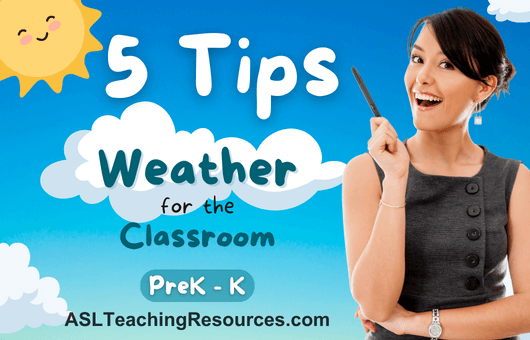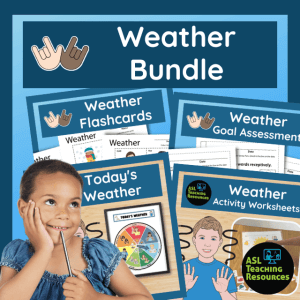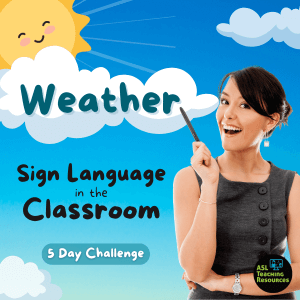Have you been searching for an engaging way to teach weather to your little learner(s)? Look no more! I’m sharing my five favorite strategies for teaching a fun weather unit to preschoolers, kindergarteners, or students with special needs.
Tip # 1: Assessment Strategies
We know there are better ways to determine your students’ knowledge than checking off items on a list or giving a test. We need ideas on how to test every student in a way that works for everyone. So here are a few assessment strategies for teaching that you can use to collect data and learn about your little learners’ progress.
Tracking Goals
Setting weather-related goals and tracking relevant student metrics are great ways to motivate your students to be more engaged in learning about the weather while giving them a sense of accomplishment.
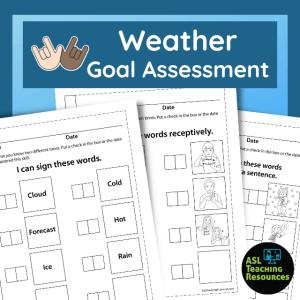 There is no need to create the assessment when you can access My Weather Goal Book to track each student’s progress as you teach the weather unit. These focus on 14 of elementary education’s most common weather-related words. In addition, you’ll be able to track their knowledge of recognizing words in English, Sign Language, and fingerspelling. If the child struggles with reading, you’ll also be able to make an assessment using icons representing each word.
There is no need to create the assessment when you can access My Weather Goal Book to track each student’s progress as you teach the weather unit. These focus on 14 of elementary education’s most common weather-related words. In addition, you’ll be able to track their knowledge of recognizing words in English, Sign Language, and fingerspelling. If the child struggles with reading, you’ll also be able to make an assessment using icons representing each word.
Begin by getting the child engaged in this process by printing off their unique “My Weather Goal Book” for them to color and draw themselves on the cover. Then, let them help you by checking off the boxes as they reach their goals. This fillable goal tracker will allow you to track your student’s progress on your computer. In addition, you’ll be able to create your own goals with the extra worksheet to meet each student’s goals.
This one-of-a-kind goal book is only available in the Teaching the Weather bundle, which includes everything you need to kick-start your weather unit.
Activities and Worksheets
You can judge the kids’ work based on how creative they are, how well they understand the lesson, and how well they know the subject by watching them do worksheets or artwork related to the lesson.
If you’re like me, you love love, love for someone to hand you everything you need for teaching the weather unit. Am I right? You’re in luck! In the Weather Lesson Plan Book, you’ll get immediate access to a 14-lesson plan to teach your children themed-based weather lessons. Teachers, childcare providers, parents, and anyone looking for weather-related sign language lessons can use this resource!
Incorporate the Weather Lesson Plan Book for even more hands-on activities, such as:
- Creative Writing
- Puzzles
- Classification
- Charts
- Crafts
- Graphing
- Matching
- Tracking
- Sequencing
- and so much more!
Movement
Give your wiggly little students a chance to show what they’ve learned while gauging their progress. Allowing students to demonstrate their knowledge through whole-body movements gives them a chance to wiggle and helps them better understand the material at hand. Find opportunities to include dramatic play in the teaching of concepts across disciplines. Short sketches that serve as summaries of concepts are one option, as are roles such as “counters” in a math problem or “hands” in a clock. Allowing you to observe the students during their daily work will give you an idea of their current understanding and help identify any misconceptions they may have.
Tip #2: Strategies for Teaching Vocabulary
Identifying the vocabulary students need to learn about weather is an essential first step. By familiarizing your students with basic words like hot and cold temperatures, you make it easier for them to connect their observations to their daily environment.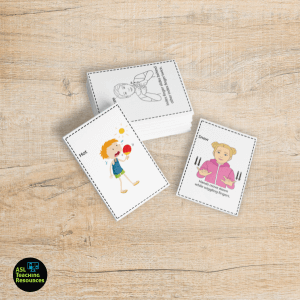
Students, as you are aware, have various learning styles. Auditory, visual, and kinesthetic are the three primary styles identified. With the Weather flashcards, you can easily teach all the ways simultaneously. We teach sign language to provide youngsters with a kinesthetic component to their learning. Don’t worry if you don’t know American Sign Language. In addition to learning how to sign the vocabulary, you can use the included QR code to watch the videos with your students as you teach lessons.
Prepare your classroom for the weather unit by hanging up a wall chart. Students can use the included mini charts as guides while studying their flashcards independently. Having something tangible for the kids to handle and investigate during your weather-related vocabulary lessons is sure to be a hit.

Here is our best practice for teaching sign language. First, say the word aloud three times while pointing to the “RAIN” weather poster. Then have the children say it three times with you. Next, point to the same poster, but this time sign and say it three times, followed by them repeating the sign while saying it three times. For older students, you would then repeat, but this time fingerspell the word as you say each letter in English.
Want a few additional fun ideas?
- Say the word and have the students sign it.
- Sign the word and have the students say it.
- Say or sign a word for them to all line up in front of the poster
- Use the Weather Dice Game for students to play in pairs or small groups.
- Pair up students to play the Weather Fortune Teller game.
- Use the Online Weather Vocabulary games for an independent review at school or home.
Join the Weather in the Classroom Challenge
Join the 5-Day Weather in the Classroom Challenge. This 5-day challenge will give you resources and strategies for teaching the weather in your classroom. During this Weather Challenge, you will receive…
✅ Daily quick, actionable wins for your classroom.
✅ Themed lessons Ideas.
✅ Tips for using Sign Language in the classroom.
✅ 5 no/low prep activities & more.
To learn more information and to sign up, click here.
Tip #3: Classroom Instruction Strategies of an Effective Teacher
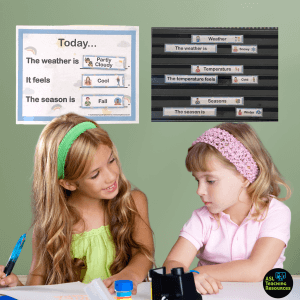 Using a weather-related theme in your classroom decor is a great way to get your students interested and involved in what you’re teaching them. For example, choose a location in your room to hang a Weather Calendar so that students can keep track of the daily weather conditions.
Using a weather-related theme in your classroom decor is a great way to get your students interested and involved in what you’re teaching them. For example, choose a location in your room to hang a Weather Calendar so that students can keep track of the daily weather conditions.
Assign two students to monitor and record the weather daily to maximize effectiveness. For example, the first person might look outside and sign the weather, and the second person might mark the chart to reflect what was signed. You can also check the weather later in the day to observe temperature changes. Then, have the entire class use the Tracking the Weather lesson to collect data for the week or the month.
Want a few additional ideas?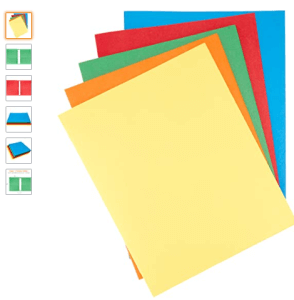
- Have students color the weather each morning on a weather wheel.
- Attach the Daily Weather Record-Journal to their weather folder to visually mark that day’s weather.
- Send home a version for them to keep track of the temperature.
- Use Weather Rhymes
Tip #4: Strategies for Teaching and Learning Activities
Rather than being told about something, our children learn by doing, touching, investigating, or experiencing it. As a result, that child creates neural pathways in the brain for future comprehension. For early childhood educators looking for ways to improve children’s learning, hands-on experiences are essential.
So how do you maximize children’s hands-on learning? Here are a few ideas:
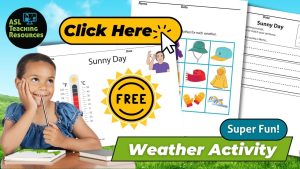 To teach students about the weather, use weather-related matching activities. Begin by using the Weather Activity Worksheets. Your students will love sorting clothing and activities to match rainy, snowy, or sunny weather conditions. I recommend laminating these weather mats and sorting cards for longevity. Children can work alone or in pairs by putting the right clothes or activities on the mats that match the weather.
To teach students about the weather, use weather-related matching activities. Begin by using the Weather Activity Worksheets. Your students will love sorting clothing and activities to match rainy, snowy, or sunny weather conditions. I recommend laminating these weather mats and sorting cards for longevity. Children can work alone or in pairs by putting the right clothes or activities on the mats that match the weather.
I love this activity because it is excellent for observing and assessing if they understand the weather’s relationship to their chosen clothes and activities. In addition, they begin thinking about what they would wear or do in real life.
Additional hands-on activities:
- Plan Your Outfits. Look at the weather forecast for the week and have them tell you what they would wear.
- Dramatic Play. Have different bags of clothing articles for a cold or hot day. Have the children sign and say the weather when they open their bags.
- Sensory Play. Children’s brains are active and grow when they use their senses to explore the world.
- Send a note to caregivers encouraging them to help their children pick the correct clothes for that week’s weather.
Tip #5: Strategies for Teaching Reading
Books are an effective way to introduce children to the fundamental concepts of the weather. Think about using children’s books to tell them stories about weather, storms, clouds, and other things. I love using these strategies for teaching to encourage my little readers.
- Read Aloud. Ask your children questions about the story to help them develop the concept of the story. Remember to select a variety of books for story time! A trip to the library is a terrific way to discover new books while also making your child feel invested in the story because he or she chose it. I love using ASL storytelling on my smartboard as an additional way to engage my young readers.
- Use what they know—known as Environmental Print. What does “environmental print” mean? It’s your child’s first chance to “read” the words he or she sees daily. Children can learn about print in their environment by interacting with these visuals that repeat.
- Rhymes. The easiest way to learn new words is to put them into rhymes. Rhyming and other word games can help your child hear the differences between sounds and understand that words are made up of individual sounds. In addition, your child will learn to read and write better if he or she can rhyme.
- Dramatic Play. Bring out the costumes and have your child tell you a story. It could be a familiar story or one made up on the spot. Ask them who the characters are, where the story is, and why the characters did what they did in the story. It makes your child’s game a little bit more like school.
Build Your Weather Library with these books:
What is the Weather?
Exploring My World Clouds
Worm Weather
Lightening
What’s the Weather
Weather Words and What They Mean
The Snowy Day Board Book
Curious About Snow
Sunshine
Additional Weather Resources
Simple Ways to Teach Preschoolers About Clouds

